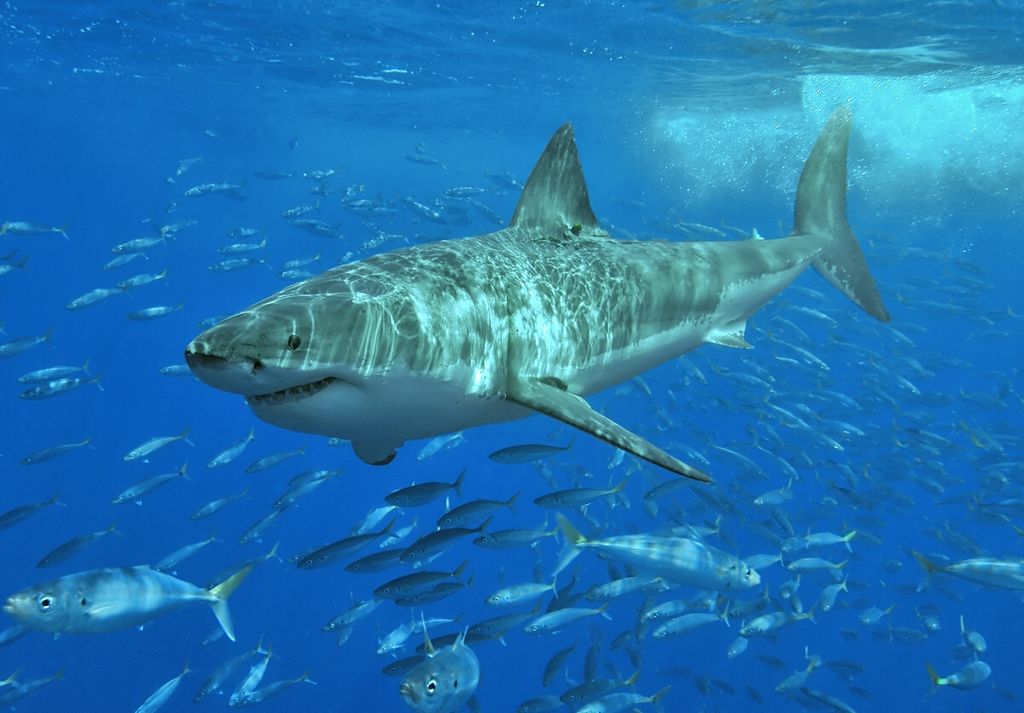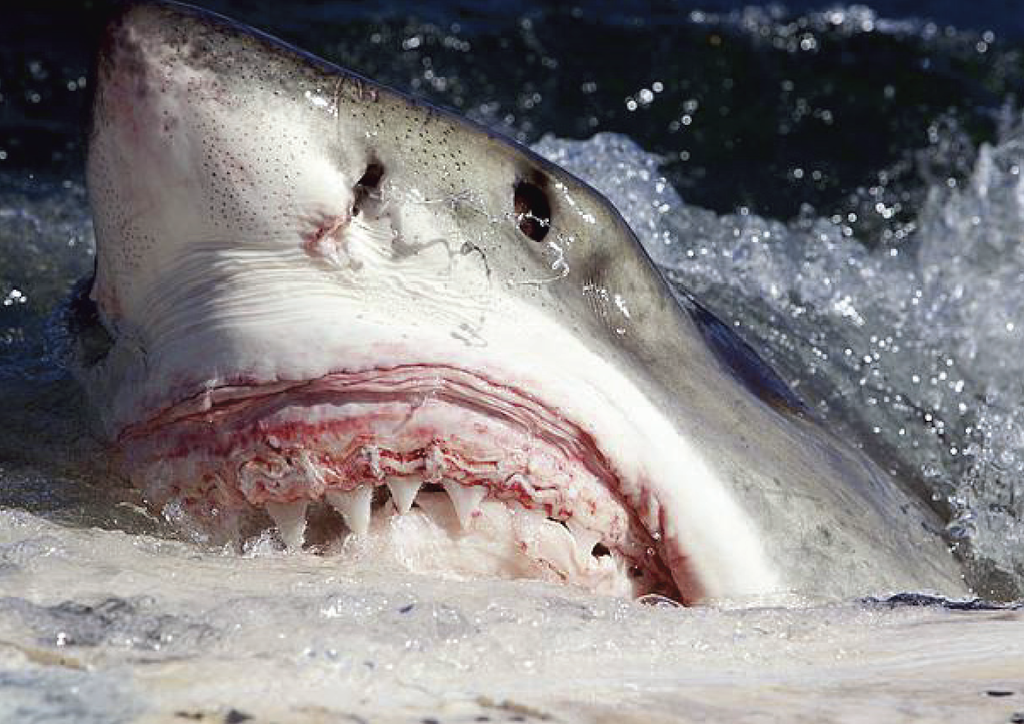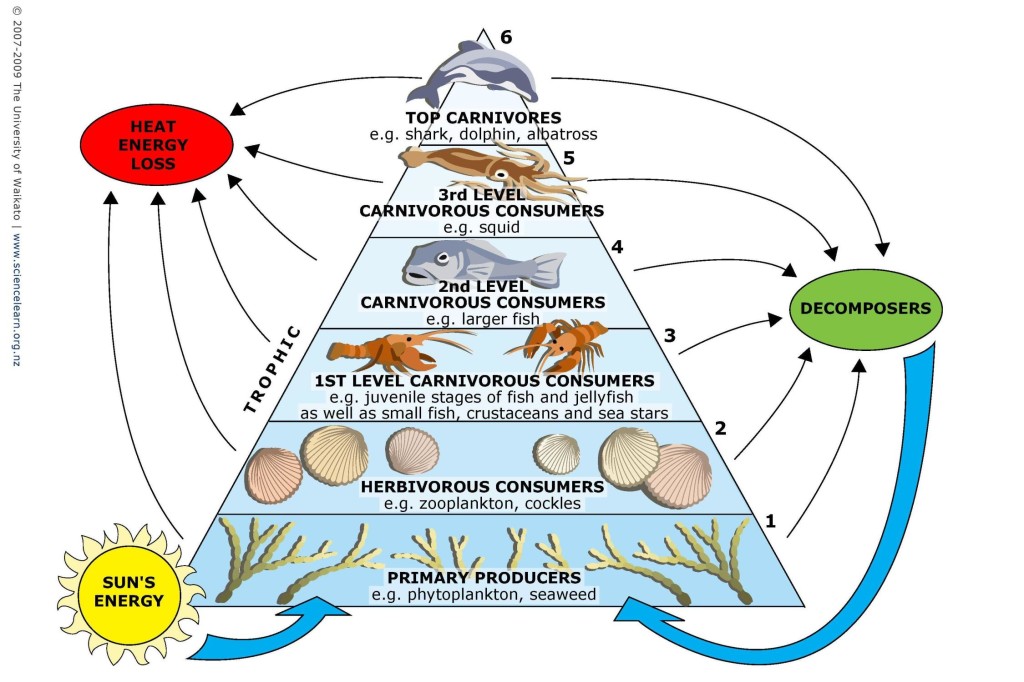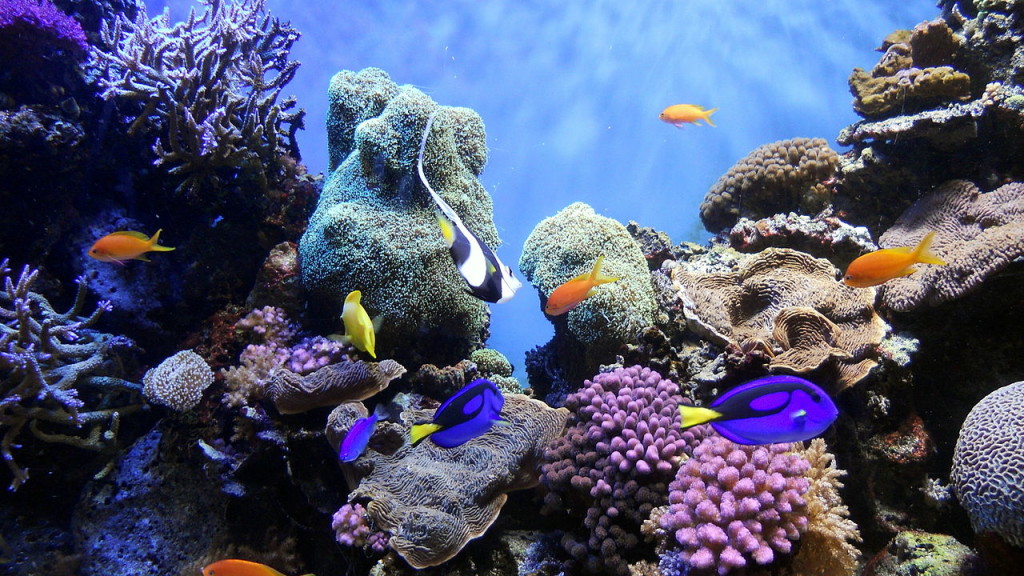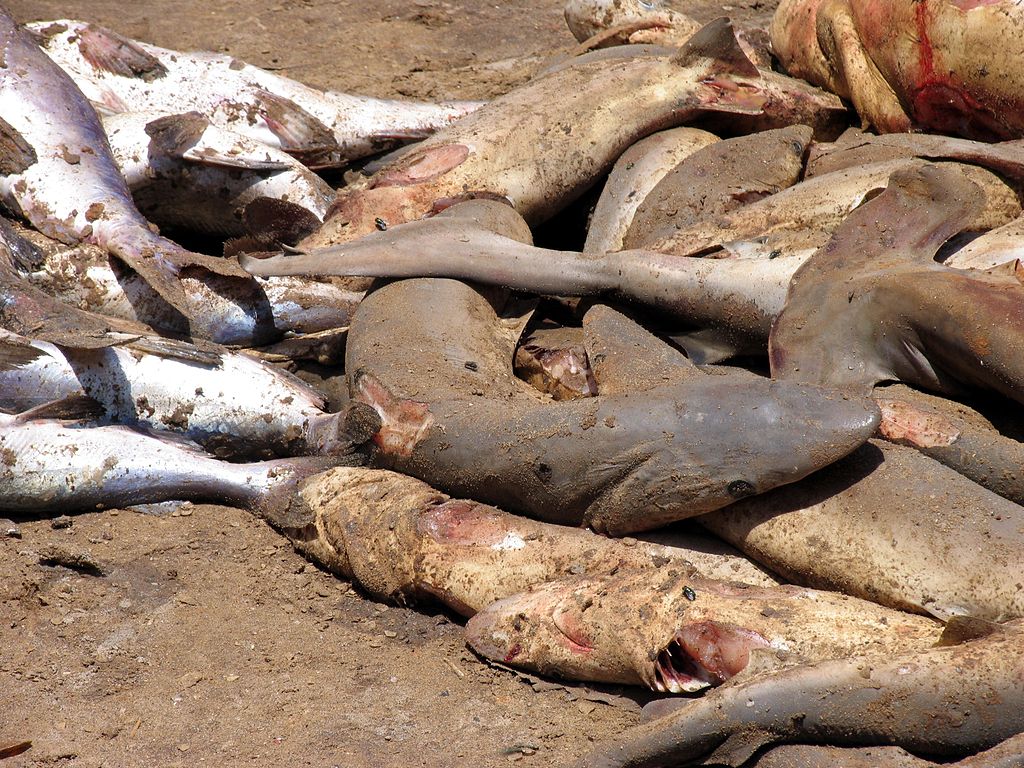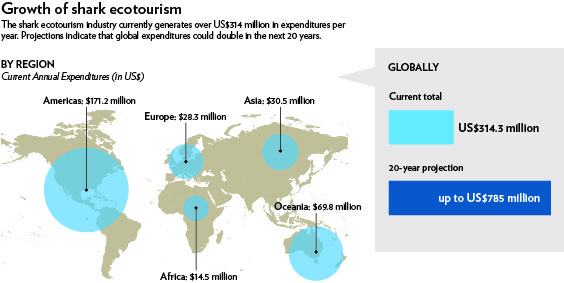Yesterday we mentioned the abundance of Atlantic shark activity, and rather than just stop there, we thought that it would be worthwhile to spend a little bit more time talking about this species that is crucially important to ocean health. Think of today’s post as the highlight reel about the role sharks play in the world’s oceans and why it’s important to conserve these predators. Yes, you read that correctly, while we’re the first to raise our hands and say that we could do without a shark sighting at our beach, we’re also the first to support all efforts to study and conserve them too. Read on to find out why…
Before we get started ~ 1. there’s at least one image in this post that readers may find offensive (it’s in the “Estimating the Sharks’ Value” section), 2. I provide some definitions and clarify some terminology at the bottom of the post (you may find it useful to go there first).
Apex Species
Many sharks are apex predators within their ecosystems. This means that they hold the top trophic position within the ecosystem’s food chain, feeding on lower-level predators, and having relatively few animals that prey on them.
It is most common for sharks to feed on the weak, old, and unhealthy fish within their prey populations. This is extremely helpful in terms of bolstering the health of the entire prey species, because it weeds out the unhealthy fish from the genetic pool, increasing the likelihood that only the healthiest of individuals within the prey population are mating and passing on their genetic material to the next generation.
Sharks’ presence within ecosystems has been observed to change the behavior of both prey and non-prey species. When sharks aren’t present, individuals within the prey population are found to congregate in areas with the highest quality food supply, and this can result in overgrazing in specific areas, leading to a degraded ecosystem. When sharks are present, individuals within the prey populations do not congregate, but spread out, and will often graze in areas of the ecosystem with lower quality food supplies. While this sounds detrimental, it actually benefits the entire ecosystem by eliminating the focused over-grazing that would occur.
Fun fact : when it comes to prey, sharks aren’t interested in humans. Really! Sharks may take a big bite out of a human, but they stop there once they realize that they picked the wrong prey. As a result, fatal shark attacks are due to the victim bleeding out, not because the shark ate the individual.
Ecosystem Health
Generally, we like to assume that nature knows best, and removing or drastically reducing the population of any one species will have consequences for the entire ecosystem. In the case of apex predators, this is particularly true, and the effects are much more amplified than removing a species that is at a lower trophic level on the food chain. Why? Generally speaking, there are much fewer apex predator species within any ecosystem than there are species at lower trophic levels. What this means is that if the apex predators are removed, there many not be another species to take on its role within the ecosystem (think about the wolves in Yellowstone – wolves were the top predator and once removed there was not another top predator waiting in the wings to manage the elk populations), but if a lower trophic level species is removed from the ecosystem, there’s often another population that shared a similar role within the ecosystem.
When sharks are removed from an area, the species they preyed upon expands. This means two things: 1. there is more direct culling of the weak, old, and sick individuals within the prey population, and 2. the prey population as a whole will expand.
This is the start of a cascade effect that throws the whole ecosystem out of balance. As the prey species expands, the demand for their food supply increases. This will reduce the populations of species lower down on the food chain. And the cascade continues as you see a see-saw effect where as the population at one level on the food chain expands, the population at the next level declines, and on and on down the food chain.
What does this mean in different ecosystems?
Along the Atlantic coast of the US, a reduction in key shark species has led to the decline and, in at least one case, the complete loss of scallop harvests. How? In that region the sharks prey upon a variety of skate, ray, and other small shark species. Within the top-level sharks, their prey populations increased. One particular species is the cownose ray, which eats bay scallops, oysters, and clams, saw an average population increase of 8% per year. As the the ray population increased, the scallop populations, in particular, declined. The ray population migrates along the east coast of the US, and by the early 2000s, its population was so large that it would consume the entire scallop population along the North Carolina coast; by 2004 the state’s bay scallop fisheries were shut down because of the elimination of the scallops by the rays.
In tropical regions, there is a relationship between the health of coral reefs and the presence of top-level sharks. When sharks are present, mid-size predator populations increase, the herbivorous fish populations at the next level decrease, resulting in an increase in the seaweed and algae growth, which smothers the coral. This research shows how the presence and absence of shark populations directly impacted two different reef zones. But the relationship isn’t one way, other research shows that healthier reefs make for better shark habitat; which may be obvious, but it’s always worthwhile to try to understand species interactions from both directions, i.e. the sharks help to maintain a healthy reef, and if given the choice, they are more likely to be found in areas with a flourishing coral population.
Population Data
Great white shark populations were on the decline from the mid-century through the 70s and 80s, but a couple of new studies show that their numbers are up in both the Pacific and Atlantic oceans! This is exciting news and demonstrates the effectiveness of state and federal bans on great white shark fishing. The US’s federal ban began in 1997, and we were the third country to protect this species after South Africa (1991) and Namibia (1993).
While those two studies provide much needed information about one species along the US coast, in order to truly evaluate the health of the world’s oceans, information is needed about the populations of other great sharks. On Tuesday, Global FinPrint announced the start of the first ever global shark census, which will take place over the next three years and is currently supported by $4 million in funding. The project will use baited underwater cameras to collect information about shark populations.
Estimating the Sharks’ Value
It’s unfortunate that we have to say this, but in addition to scientific studies supporting the importance of sharks in the ecosystem, conservation efforts are often amplified when there is an economic benefit to the work.
In the case of sharks, millions are killed every year for their fins. The fins are used to make shark fin soup in China. The soup is consumed at weddings, banquets, and important business events, where consumers believe that eating it represents wealth, power, prestige, honor (we believe it represents selfishness), increases sexual potency, cures cancer, improves the health of different organs (there is no scientific evidence behind any of these claims. As China has grown economically, so *was* the demand for shark fin soup. It was estimated to be growing at 5% per year in the early 2000s.
The unfortunate truth is that the demand for fins is so high but there is little economic value associated with the rest of the animal, so fisherman practice what they call “finning”. They cut off the fin of the shark and throw the animal back in the ocean to die. Every year, millions of fins are used to make the soup, this means millions of sharks are dying. Many people understand this to be a cruel act and believe that these predators have an intrinsic value as a living organism. Others also understand that sharks should be valued for their crucial role in maintaining ecosystem health, as discussed above, yet it’s hard to please a measurement on these values.
Fortunately, within the last decade, shark fin soup has begun to move out of fashion, much of this helped along by famous Chinese personalities speaking out against the consumption of the dish. Pressure on the Chinese government resulted in them to stop serving any dishes made from protected wildlife. Anecdotal evidence suggests that the global fin trade has declined in the past few years, and that the price for fins is declining!
For better or worse, money is often used to place a comparable value on something, but it’s hard to place a specific dollar value on a shark’s intrinsic “worth” and on the role they play in ecosystem health. Fortunately, we can place a lower level estimate on what people are willing to pay to save them by looking at markets that do have a dollar value. We can look at the revenue generated by the market for scallops, which are wiped out when sharks are eliminated from certain ecosystems. We can also look at what tourists are willing to pay to visit an ecosystem that has sharks and/or participate in shark-related activities.
What do the numbers say?
A 2013 study examining shark fisheries and ecotourism destinations at 70 sites within 45 countries priced the global shark trade at approximately $630 million US dollars. At the same time, they measured global shark ecotourism to be worth $314 million, and their data suggests that it will reach over $700 million within the next 20 years. Those numbers suggest that sharks are, or will be, worth more alive an in the oceans than dead. And again, that study is just looking at what we are willing to pay to either eat or see sharks, it’s not taking into account the value that sharks have for maintaining the health of the ecosystems!
Always More to Learn…
This is purely my opinion, but I think that because we see such amazingly well-done nature shows and learn a bunch of facts when watching documentaries, we (the layperson) tend to start to believe that scientists know all that there is to know about some species, but that just isn’t the case. There’s so much left to learn about our wild neighbors.
As I mentioned above, the scientific community is still working to understand just how many sharks inhabit today’s oceans. In addition to that work, we’re still learning about the behavior of these animals. For example, as we mentioned yesterday, scientists have never even observed great white sharks mate. Here are links to some of the most recent shark research:
- A new study that came out on June 9th, provided new information about the long migration patterns of tiger sharks between the North Atlantic and Caribbean. Work like this may help us to identify habitats which are crucial to protect when trying to preserve the species.
- This spring, scientists identified a specimen collected along the Gulf Coast in 2010 as a pocket shark. These creatures are so rare that is only the second pocket shark to have ever been identified; the first observation occurring off the coast of Peru in 1979!
Vocabulary & References
I thought it might be helpful to provide definitions for some words used in this post and to clarify my use of other terms.
-
food chain vs. food web – technically, predator-prey interactions in the wild are not as simple as the single pathway suggested by a food chain. It’s often more precise for one predator to eat multiple types of prey, and then some of those prey species may eat one another in addition to other prey species at lower trophic levels. It is more precise to represent these many interactions as a food web. To keep the discussion above simple, I represented many of the predator-prey interactions as if they were simple food chains, but in reality, the relationships should be more accurately represented as a web of interactions.
-
ecosystem – a community of living organisms, many of which interact through predator-prey relationships, as well as the physical environment (water, air, minerals).
-
trophic levels – a way to identify a species place in an ecosystem. The species that share the same function, or place, in the food web relative to the primary producers are considered to be at the same trophic level. The first trophic level consists of primary producers (plants, algae, single-celled autotrophs), the second trophic level contains the primary consumers (herbivores) that eat the plants, next are the secondary consumers, and so on up the food web until you get to a species like the great sharks which are often the final consumers within their ecosystem, and throughout the system are the detritivores or decomposers.

